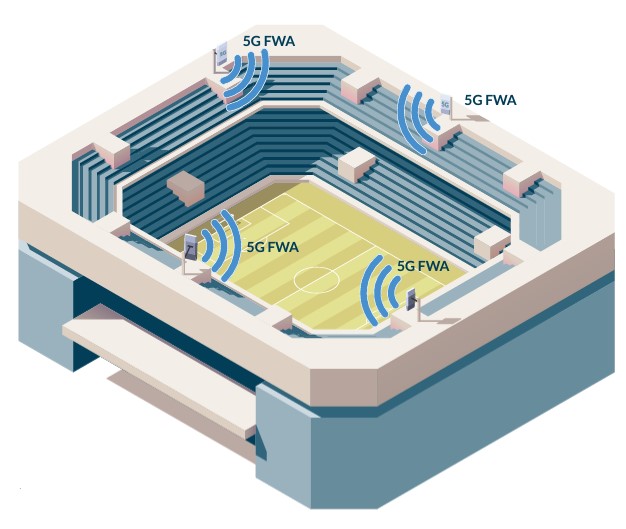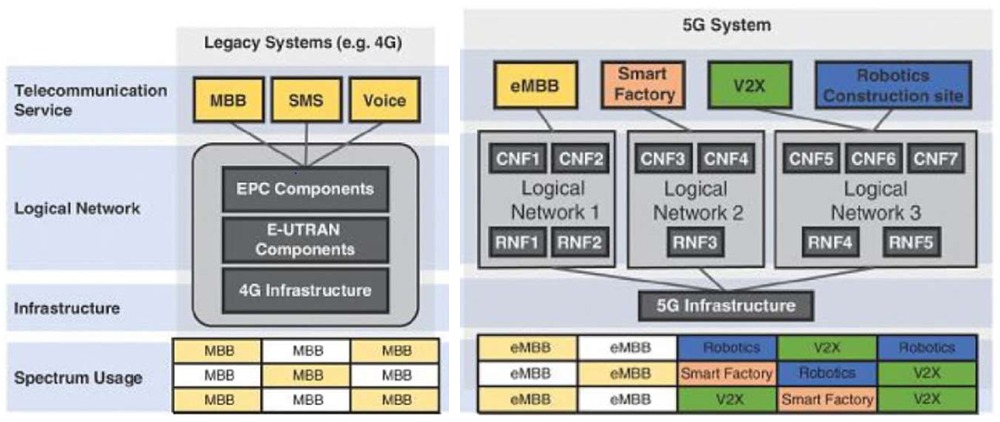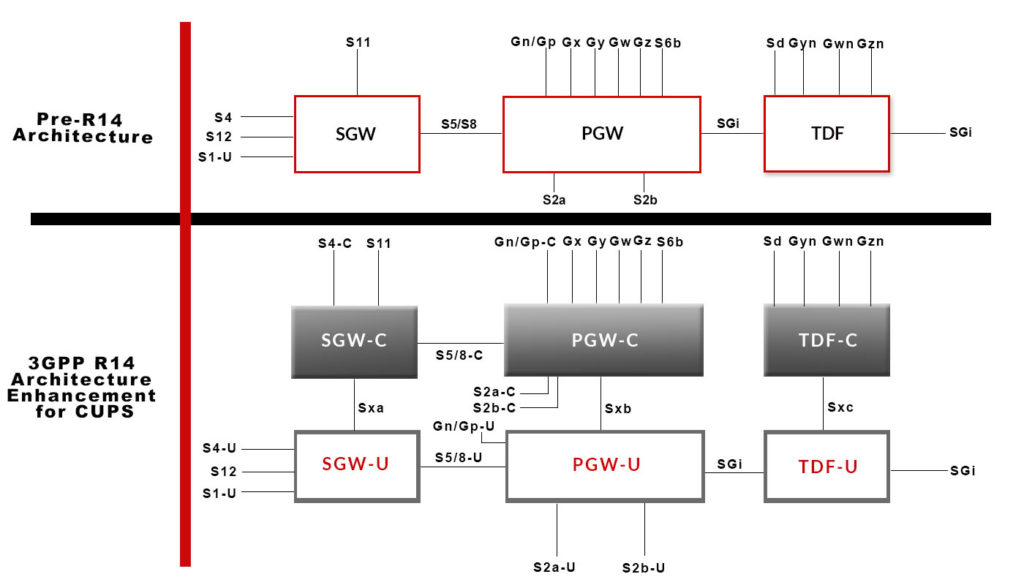Migration to a 5G Core for the support of 5G standalone (SA) operation is an essential step for Mobile Carriers to avoid evolution constraints arising from a long term dependency of NR on LTE. A general SA introduction is mainly driven by the market need to rapidly expand NR coverage with a nationwide target. Low band deployment using non-standalone (NSA) is currently constrained by the lack of support for low-low EN-DC band combinations in terminals. Still, this restriction eases over time as support is introduced into first terminals later this year and into most new devices by 2023.
5G NR Non-standalone (NSA)
The main 5G Non-Standalone operating principle is the use of existing LTE infrastructure and the EPC rather than a new 5G core network. In this case, the User Equipment (UE) camps on LTE in idle mode and the NR carrier is added as a secondary carrier upon decision of LTE. This is typically a traffic-related trigger, either based on the buffer status or the QoS. The handover of the primary carrier is always controlled by LTE. In some NSA deployment options, there is the possibility of transferring the user plane anchor point to NR. This avoids the need to route user plane traffic via LTE, while the radio resource control remains on the LTE primary carrier.
5G NR Standalone (SA)
The term Standalone (SA) is typically used for a 5G gNodeB that is not using the existing LTE infrastructure and the ePC but a new 5G Core. However, this term is not used consistently within the industry. A most appropriate generic definition would be the support of NR operation without dependence on LTE to provide the Master node, i.e. use NR as the master. With this definition, NR is standalone in the sense that the addition of the secondary LTE eNB could be optional according to which deployment option is used. Note that another common usage is that the addition of the secondary LTE node is not supported at all (option 2 only). 3GPP has standardized several NSA & SA architecture options. All 5G SA options are based upon a new 5G Core. In SA operation, terminals are steered between options by the network, while Base stations will simultaneously support several different options, depending on the served UE.
5G Core drivers
The introduction of 5G Core is driven by several factors. A 5G Core is needed to allow NR to migrate away from non-standalone and support NR operation with no fundamental LTE dependency constraint. From an ecosystem perspective, 3GPP focus their work on 5G Core rather than on EPC evolution. Operators will, therefore, not be able to deviate from the ecosystem mainstream, and it is rather a question of timing than a question of if to deploy 5G Core at all.
From a RAN perspective, a new 5G Core will exploit the coverage of NR deployment without LTE coverage dependencies, such as in the case of 700 MHz and small cell deployment. In particular, the full coverage benefits of NR deployment at 700 MHz may not be realized without SA as many terminals require the use of an LTE anchor in the mid-bands when using NSA. Furthermore, a 5G Core will provide lower control plane latency with quick access to NR low-latency bearer from a power-efficient UE state in NR. Currently, NR is not in control of when it is used and of the primary cell selection (re-selection and handover procedures). From a Campus Network perspective, it is obvious that the evolution of campus networks is driven towards 5G technology. The evolved campus networks will benefit from 5G Core capabilities like new network-IDs, slicing, and layer2 based networking.
In the Fixed & Mobile Convergence (FMC) area, the 5G Core is inherently designed as a converged network, such as the ATSSS function, which supports traffic paths via multiple access networks and can provide the route towards a future FMC offering. Last but not least, 5G Core offers enhanced security mechanisms such as integrity protection of the user plane. New security mechanisms do not impact the mobility between 5G Core and EPC within a new Combo-core. The security context can be transferred between EPC and 5G Core, while re-authentication might be requested when moving to 5G Core, but in a non-time critical way after the handover. No new SIMs are expected to be needed for a 5G Core connection, and the data required by a UE to use 5G is anticipated to be provisioned via over-the-air (OTA).
5G Core timeframe
Most Operators aim to support a mainstream introduction of SA using 5G Core in 2022-23 to increase the terminal base benefiting from low band deployments. After this time, other factors will drive SA introduction, such as slicing, FMC, low latency, etc. Small scale deployments of 5G Core should start earlier, in 2H 2021, e.g., for Campus deployment.
Many countries are expected to postpone the mainstream use of SA in urban areas until a high penetration of NR-supporting terminals is reached, probably 2025 or later. According to which NR deployment option is used, rapid penetration of NR-supporting terminals should allow many LTE-only carriers to be switched to NR-only carriers without using DSS. The use of SA might still be supported in certain areas (e.g., rural) or for applications insensitive to the user data rate. Handover to LTE when leaving the NR coverage area is enabled by a new Combo-core supporting 5GC and EPC and interworking between them. Rapid increasing NR footprint after SA introduction is recommended to shrink the LTE-only area not connected to the 5G Core.
5G Core Introduction
An SA introduction, at least for the initial mainstream eMBB services, requires a fast nationwide NR coverage. However, NR coverage especially in rural areas requires the activation and deployment of NR in low bands (e.g., 700 MHz). 700 MHz deployments will take several years to reach nationwide coverage. On the other hand, NR coverage in low bands without SA is constrained by the terminal ability to support low-low band ENDC combinations. Without such support, NR coverage depends upon an LTE mid-band anchor, limiting coverage and potentially adding cost. Low-low ENDC band combination terminal support timelines are not clear. The current expectation is for first terminals in 2020, with support rising to around 50% of new phones in 2022. The majority of the terminal base in 2023 will not have this capability, but support should increase thereafter. SA support activation is assumed to be handled by SW download from terminal supplier server, however, suitable HW to support the needed band combinations should already be present in the terminals.
Legacy EPC needs to be kept in operation for a long time to support older terminals, including 4G CSFB terminals. Interworking between 5G Core and its associated EPC is needed to allow UEs to handover to LTE cells outside of NR coverage area. All LTE and NR base stations should be connected to the new Combo-core supporting EPC/5GC. In the meantime, all mainstream services should be supported on the new Combo-core to avoid the need to fall-back to NSA with its dependency on LTE. In full 5G Core and SA operation, there should be no requirement on new 5G customers to fallback from NR to any of the legacy technologies to enable connection to any mainstream service.
Some countries also face a 700 MHz coverage obligation by 2022. To support such deployments, the aim is for a mainstream introduction of SA using a 5G Core in 2022 and towards 2023. All NR base stations will be connected to a 5G Core, with SA support being activated over the full NR footprint. The new 5G Core is expected to support all mainstream services, including eMMB and the initial URLLC services by 2022-23. All LTE base stations will be connected to the associated EPC, an EPC supporting interworking with 5G Core. A selection mechanism will be needed to select the appropriate packet core network, based upon both customer subscription and terminal capability. For example a Combo-core 5GC for migrated users with SA-supporting terminals, accessing NR cell and Combo-core EPC for VoLTE support and NSA terminals accessing LTE cell. Legacy EPC will be used for non-migrated users.













